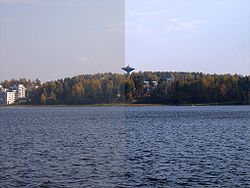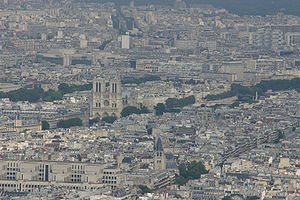.gif)
Contrast (vision)
Encyclopedia


Visual perception
Visual perception is the ability to interpret information and surroundings from the effects of visible light reaching the eye. The resulting perception is also known as eyesight, sight, or vision...
of the real world, contrast is determined by the difference in the color
Color
Color or colour is the visual perceptual property corresponding in humans to the categories called red, green, blue and others. Color derives from the spectrum of light interacting in the eye with the spectral sensitivities of the light receptors...
and brightness
Brightness
Brightness is an attribute of visual perception in which a source appears to be radiating or reflecting light. In other words, brightness is the perception elicited by the luminance of a visual target...
of the object and other objects within the same field of view
Field of view
The field of view is the extent of the observable world that is seen at any given moment....
. Because the human visual system is more sensitive to contrast than absolute luminance
Luminance
Luminance is a photometric measure of the luminous intensity per unit area of light travelling in a given direction. It describes the amount of light that passes through or is emitted from a particular area, and falls within a given solid angle. The SI unit for luminance is candela per square...
, we can perceive the world similarly regardless of the huge changes in illumination over the day or from place to place.
The human contrast sensitivity function shows a typical band-pass shape peaking at around 4 cycles per degree with sensitivity dropping off either side of the peak. This tells us that the human visual system
Visual system
The visual system is the part of the central nervous system which enables organisms to process visual detail, as well as enabling several non-image forming photoresponse functions. It interprets information from visible light to build a representation of the surrounding world...
is most sensitive in detecting contrast differences occurring at 4 cycles per degree, i.e. at this spatial frequency
Spatial frequency
In mathematics, physics, and engineering, spatial frequency is a characteristic of any structure that is periodic across position in space. The spatial frequency is a measure of how often sinusoidal components of the structure repeat per unit of distance. The SI unit of spatial frequency is...
humans can detect lower contrast differences than at any other spatial frequency.
The high-frequency cut-off represents the optical
Optics
Optics is the branch of physics which involves the behavior and properties of light, including its interactions with matter and the construction of instruments that use or detect it. Optics usually describes the behavior of visible, ultraviolet, and infrared light...
limitations of the visual system's ability to resolve
Optical resolution
Optical resolution describes the ability of an imaging system to resolve detail in the object that is being imaged.An imaging system may have many individual components including a lens and recording and display components...
detail and is typically about 60 cycles per degree. The high-frequency cut-off is related to the packing density of the retina
Retina
The vertebrate retina is a light-sensitive tissue lining the inner surface of the eye. The optics of the eye create an image of the visual world on the retina, which serves much the same function as the film in a camera. Light striking the retina initiates a cascade of chemical and electrical...
l photoreceptor cells: a finer matrix can resolve finer gratings.
The low frequency drop-off is due to lateral inhibition
Lateral inhibition
In neurobiology, lateral inhibition is the capacity of an excited neuron to reduce the activity of its neighbors. Lateral inhibition sharpens the spatial profile of excitation in response to a localized stimulus.-Sensory inhibition:...
within the retinal ganglion cell
Ganglion cell
A retinal ganglion cell is a type of neuron located near the inner surface of the retina of the eye. It receives visual information from photoreceptors via two intermediate neuron types: bipolar cells and amacrine cells...
s. A typical retinal ganglion cell presents a centre region with either excitation or inhibition and a surround region with the opposite sign. By using coarse gratings, the bright bands fall on the inhibitory as well as the excitatory region of the ganglion cell resulting in lateral inhibition and account for the low-frequency drop-off of the human contrast sensitivity function.
One experimental phenomenon is the inhibition of blue in the periphery if blue light is displayed against white, leading to a yellow surrounding. The yellow is derived from the inhibition of blue on the surroundings by the center. Since white minus blue is red and green, this mixes to become yellow.
For example, in the case of graphical computer displays, contrast depends on the properties of the picture source or file and the properties of the computer display, including its variable settings. For some screens the angle between the screen surface and the observer's line of sight is also important.
Contrast is also the difference between the color or shading of the printed material on a document and the background on which it is printed, for example in optical character recognition
Optical character recognition
Optical character recognition, usually abbreviated to OCR, is the mechanical or electronic translation of scanned images of handwritten, typewritten or printed text into machine-encoded text. It is widely used to convert books and documents into electronic files, to computerize a record-keeping...
.
Formula


Various definitions of contrast are used in different situations. Here, luminance
Luminance
Luminance is a photometric measure of the luminous intensity per unit area of light travelling in a given direction. It describes the amount of light that passes through or is emitted from a particular area, and falls within a given solid angle. The SI unit for luminance is candela per square...
contrast is used as an example, but the formulas can also be applied to other physical quantities. In many cases, the definitions of contrast represent a ratio of the type

The rationale behind this is that a small difference is negligible if the average luminance is high, while the same small difference matters if the average luminance is low (see Weber–Fechner law
Weber–Fechner law
The Weber–Fechner law is a confusing term, because it combines two different laws. Some authors use the term to mean Weber's law, and others Fechner's law. Fechner himself added confusion to the literature by calling his own law Weber's law...
). Below, some common definitions are given.
Weber contrast
The Weber contrast is defined as
with
 and
and  representing the luminance of the features and the background luminance, respectively. It is commonly used in cases where small features are present on a large uniform background, i.e. the average luminance is approximately equal to the background luminance.
representing the luminance of the features and the background luminance, respectively. It is commonly used in cases where small features are present on a large uniform background, i.e. the average luminance is approximately equal to the background luminance.Michelson contrast
The Michelson contrast (also known as the Visibility) is commonly used for patterns where both bright and dark features are equivalent and take up similar fractions of the area. The Michelson contrast is defined as
with
 and
and  representing the highest and lowest luminance. The denominator represents twice the average of the luminance.
representing the highest and lowest luminance. The denominator represents twice the average of the luminance. RMS contrast
Root mean squareRoot mean square
In mathematics, the root mean square , also known as the quadratic mean, is a statistical measure of the magnitude of a varying quantity. It is especially useful when variates are positive and negative, e.g., sinusoids...
(RMS) contrast does not depend on the spatial frequency content or the spatial distribution of contrast in the image. RMS contrast is defined as the standard deviation of the pixel
Pixel
In digital imaging, a pixel, or pel, is a single point in a raster image, or the smallest addressable screen element in a display device; it is the smallest unit of picture that can be represented or controlled....
intensities:

where intensities
 are the
are the  -th
-th  -th element of the two dimensional image of size
-th element of the two dimensional image of size  by
by  .
.  is the average intensity of all pixel values in the image. The image
is the average intensity of all pixel values in the image. The image  is assumed to have its pixel intensities normalized in the range
is assumed to have its pixel intensities normalized in the range  .
.Contrast sensitivity
Contrast sensitivity is a measure of the ability to discern between luminanceLuminance
Luminance is a photometric measure of the luminous intensity per unit area of light travelling in a given direction. It describes the amount of light that passes through or is emitted from a particular area, and falls within a given solid angle. The SI unit for luminance is candela per square...
s of different levels in a static image
Image
An image is an artifact, for example a two-dimensional picture, that has a similar appearance to some subject—usually a physical object or a person.-Characteristics:...
. Contrast sensitivity varies between individuals, reaching a maximum at approximately 20 years of age, and at spatial frequencies
Spatial frequency
In mathematics, physics, and engineering, spatial frequency is a characteristic of any structure that is periodic across position in space. The spatial frequency is a measure of how often sinusoidal components of the structure repeat per unit of distance. The SI unit of spatial frequency is...
of about 2–5 cycles/degree. In addition it can decline with age and also due to other factors such as cataracts and diabetic retinopathy.


